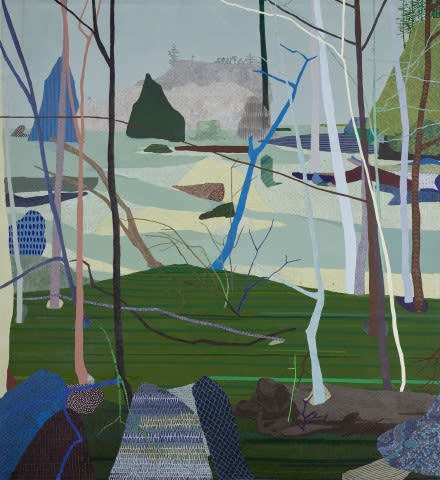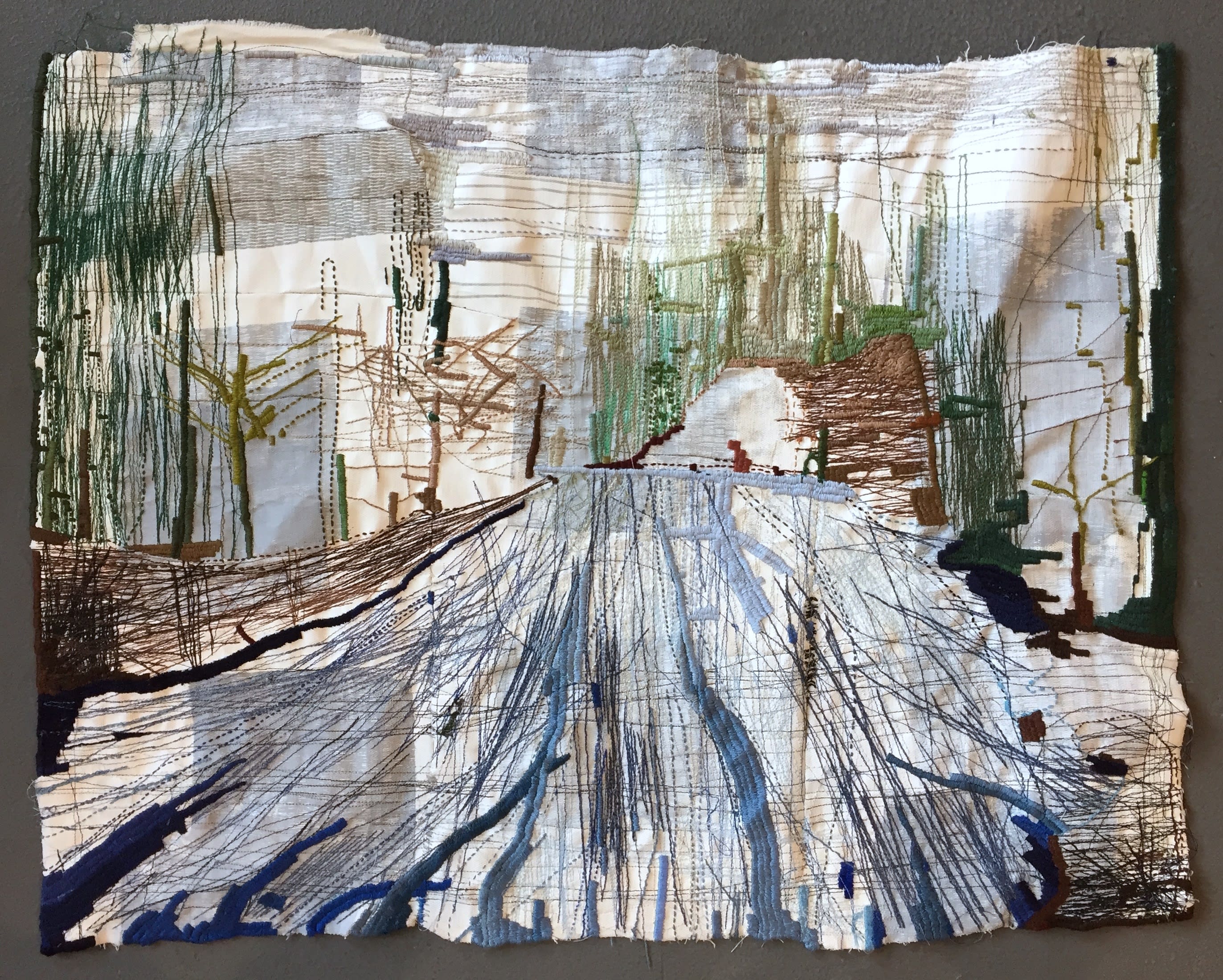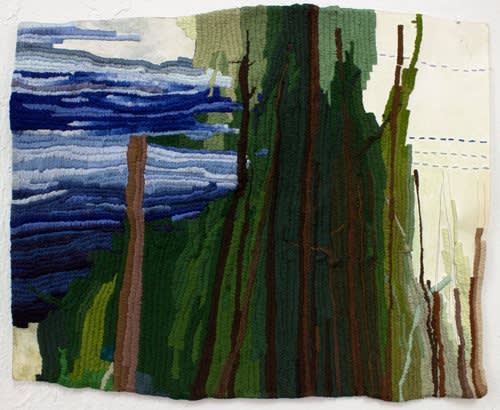
Dr. Alysia Fischer (AF) interviews Artist, Samantha Bates (SB). Alysia Fischer is an author, artist and anthropologist who lives in Weaverville, NC. She received her PhD in Anthropology from the University of Arizona and her MFA from Miami University (Ohio). Her research on crafts includes the books Hot Pursuit: Integrating Anthropology in Search of Ancient Glassblowers and Myaamia Ribbonwork (co-authored with Andrew Strack and Karen Baldwin). Alysia is also an accomplished maker, as both a glassblower and metals artist.
AF: Did you always know you were going to be an artist?
SB: My family had a lot of makers in it. My aunt does cross stitch and quilting, we used to do all these projects together and that's where I made a gift for the first time. I followed the instructions for a little napkin angel. I remember doing all the stitches and painting the face, then giving it to my mom. Every stitch was a record of my time and care. Those early experiences in making art and building gifts and doing fiber work with my family came into my practice later. But I actually fought being an artist pretty hard, even though I loved to do it for myself and I went to an arts high school. I knew that I loved to do it but I also didn't know any artists. There wasn't an artist in my family, I didn't know any. I didn't know if it was reasonable. We were a family of worker bees, you know. You take care of your family and above all you go for security and food and shelter. You get a job. If you go to school it's directly to get a job.
The idea of being an artist was just unfathomable to a fundamental part of who I was. But I couldn't not do it. I was at University of Washington for one quarter without any art classes and it was like I was completely stifled. I couldn't see my life going that way. And then the next quarter I changed my major to Painting/Drawing and I never looked back. I also think how completely lucky I am that at 18 I found something that I could do for 10 hours a day and wake up and be excited to go back to. How many people have that?
AF: How did you arrive at your distinctive style of mark making? I've seen some of your work with marks made with pens and markers and pencils and other work with embroidery and other sewn marks.
SB: The work crosses a lot of mediums in the sense that it has drawing, painting, fibers--and even within fibers there's coiling and there's machine sewing and hand-stitching. I think an umbrella that covers all of it is repeated mark and care. I wanted to continue to grow so I started asking, 'What's the hard thing that I can tackle next?' 'What's the challenging thing that I'm not sure I can do but I'm really excited about?'

Samantha Bates, Home, Stitch, Walk, Pen, screen print, machine sewn thread
and hand sewn embroidery thread on un-stretched primed canvas, 22 x 28 inches
And that's when I started the piece Reprise that's in the show. It's a really important piece for me. I didn't know if I could do it. It was nine months of focusing on one piece--which is not how I usually work--and it's hundreds of thousands of small dashes building to this imagery. The imagery comes from when you look out on the ocean of Washington and the tide has gone out and there are all these little pits in the sand that have collected water but are reflecting the light and the sky and the water. It's not strictly representational, it's abstracted, but that's where it comes from. And then there's the tide going in and out and the repetition in that and the repetition of the marks. Hundreds of thousands of dashes. It all felt like it really came together-the nature that is so important to who I am and where I live. It's in the work in a visual way, it's in the work in how I move and how I make the mark. The repetition just clicked; it became an essential part.
When I put Reprise on the wall, after working on it on a table, I didn't really know what it was going to be. I put it up and everything went silent like the on the Fourth of July when a firework goes off and everything else gets kind of quiet for just an instant. That happened. And it was such an important moment for me. I felt like I had really found something. I also realize the repetition and the mark came from a memory that I have of my grandma. My Oma passed away when I was in 5th grade but we were really close. I was her youngest of many grandkids and she'd come over to the house and we'd all get our little moments with her. My parents had this deep rug in the living room, which was a quiet room with no tv. You don't eat there. It's where guests come. My Oma liked it because she didn't like to be near any of those things. We'd sit on this plush rug and we'd kind of sink into it and straighten out the fringe. And she would say, 'How did you sleep little one?' and we would do that practice every time she came to visit. I was in grad school and trying to figure out where the repetition in my work came from. I knew the small subtleties that happened were fascinating to me. I couldn't get away from it, it was such a part of my practice. I think it stems back to those memories with my grandma and that physical action, and stitching with my aunts. Repetition in fiber work and repetition in the drawing are all the same. It also ties back to the gift giving so it's about care and labor and time and landscape.

AF: You mentioned working on the pieces while they're flat, is that always the case or was that just the one piece?
SB: It depends. Oftentimes I'll go between the two. I'll have a large table in my space and I'll work on it on a table for a week and then I'll put it up on the wall and work on it for a week. I think it's important to have both experiences. There's a tree fibers piece, Home Stretch Grow that's like 14 feet. That was constructed mostly on the ground and handstitched together. And a lot of the fiber pieces are constructed in a seated position and they feel much more intimately connected to comfort and coziness.

Samantha Bates, Stretch, Grow, Shelter, Yarn, thread, and cotton piping cord, 16' 4" x 10' 6
AF: Your works are quite large, what is important to you about the scale?
SB: I have 4 or 5 smaller pieces in the show as well. But I do really enjoy working large. I think that part of it is that I spend so much time on the work and the labor is so important to the repeated line. The larger scale allows me, and hopefully the viewer, to enter into it. It's an engulfing kind of feeling. I also think something beautiful happens with the marks where when you approach the work your experience changes. So from 10 feet away it's a landscape and then from 5 feet away it's hundreds of thousands of marks becoming abstracted and then up close maybe it's a landscape again and you get to change how you understand the work. And the second time you see it it's not like the first. I love to play with that and reward the viewer for their extended time and attention and I think sometimes there's something different about approaching a work that's larger than you and how you can feel in front of it.
AF: You mention your work draws upon the imagery of your native Washington State. How were you impacted by living in Boston [for graduate school]?
SB: It had a huge impact on my practice in general but especially this show. Up until I was 25 I lived in Washington. I had this [West] coast connection. When I was upset, when I was happy, I would go out into nature, I would go hiking, camping. It was where I thought, it was where some of my happiest memories are. It's a huge part of who I am, but then I moved to Boston. The dislocation of that was bodily. I felt isolated and separated from it. And the work called home as much as I did. Sometimes it was a comfort to me, sometimes a celebration, sometimes it was mourning.
The dislocation and separation, the yearning for home. The work was really how I visited and found that place, a shelter for me. Now I'm reveling in my reunion and so happy to be so close to those places again. Being able to go out and experience and go back to the studio and remember specific details of how your feet feel when you step into dirt. In the winter it can be hardpacked or a little bit damp and squishy and things smell differently and the sound is different. Can I bring that into the work? Can I bring the specificity and richness into the work? There's a piece, Winter's Mist, in the show. Western Washington has this dense cleansing air in the winter. It's like after it rains or everything is snow-covered and everything smells clean. It's cold but it feels like a specific, beautiful thing. I'm trying hard to find that light and that air. I like to pursue those kinds of feelings.

AF: What has it been like to work with Momentum Gallery?
SB: It's been amazing. I feel grateful and happy. I trust Momentum and they trust me. I tell my friends I'm so lucky and I can't believe it and I'll list like 20 things that are amazing: Jordan is so smart and intuitive and considerate. When he talks about the work he gets it and he's interested in it and he's been thinking about it and he's invested in you. And that's amazing. And even just the little things about pricing and framing, everything is fair and ethical and being able to trust that. I'll think 'Sam, you're lucky and it's amazing that you found each other but also you worked for ten years so when that opportunity came you were ready for it.' So there's a gratefulness, but also a pride that when an opportunity like this came to me I was ready to take advantage of it.
AF: Thank you for talking to me today.
SB: Of course.

Samantha Bates, Lean Into the Winds, Embroidery thread hand sewn into paper, 10.5 x 13.5 inches
